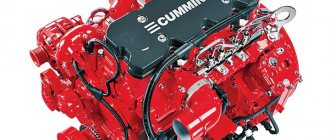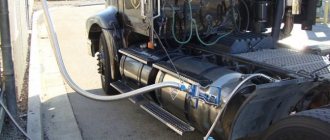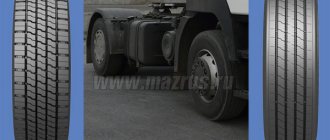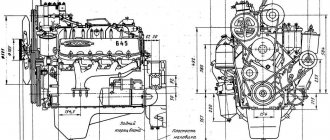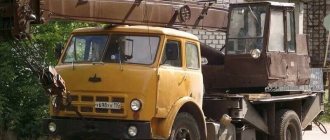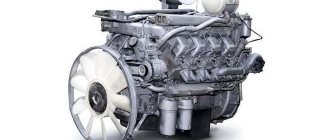Many drivers are interested in the question of why the electronics release gas on KamAZ-65115. The reason for this may be an engine malfunction, dead batteries, etc. Many people decide to self-diagnosis their car; this is not recommended, since the device system is quite complex and requires the work of a specialist.
Malfunctions: causes and what to do
The main malfunctions that require KamAZ repairs are:
- Difficulty when changing gears; engaging reverse is accompanied by a grinding noise. To eliminate the breakdown, it is recommended to adjust the free play of the clutch and the clutch release mechanism.
- Extraneous noise in the divider housing. It can be caused by an increased level of pressure in the pneumatic control system of the device, wear of the cone-shaped rings that block the chamfers of the fingers and carriage. It is necessary to adjust the pressure reducing valve and replace the synchronizer.
- If spontaneous gear disengagement occurs while driving, you need to tighten the fastenings, conduct an external inspection of the clamps and, if necessary, replace worn mechanisms.
- If a leak appears in the transmission device, you should replace the seals, wash the breathers, replace worn gaskets and tighten the fasteners.
- If the gears in the divider stop engaging, it is necessary to adjust the valves and flush the throttle.
Error codes
Electronic control system - error codes for KamAZ with a Cummins engine (Euro-4):
| 111 | Unstable operation of the module that controls the power unit. |
| 143 | Reduced oil pressure level. |
| 146 | Increased coolant temperature. |
| 214 | Overheating of oil in the system. |
| 12 | Air temperature sensor malfunction. |
| SPN 132 FMI 3 | Too much fuel consumption when starting a vehicle. |
| 35 | Malfunctions in the cruise control system. |
| 23 | Incorrect position of the gas and brake pedals. |
| 27 | Failure of the steering rack. |
| 42 | The permissible engine idle speed has been exceeded. |
| 54 | High voltage level in the on-board network. |
| 55 | Unstable operation of the ECU control unit. |
| 43 | Speedometer malfunctions. |
| 28 | Brake system malfunction. |
| 18 | Incorrect operation of the camshaft. |
| 19 | Malfunctions in the main relay system. |
| 428 | Malfunctions in the fuel fluid sensor. |
| 595 | The number of turbocharging revolutions has been exceeded. |
| 281 | Incorrect position of the Bosch injection pump valves. |
| 422 | Insufficient amount of coolant. |
| 245 | Reduced pressure level in the fan control circuit. |
| 598 | Low voltage in the generator set circuit. |
| 1139 | Unstable operation of injector No. 1. |
| 441 | Low battery charge. |
| 442 | Recharging the battery. |
| 325 | Fuel consumption does not correspond to vehicle speed. |
| 434 | The network power has failed. |
| 2266 | Incorrect operation of the starting pump. |
| 687 | The number of turbocharger revolutions is reduced. |
| 126 | Working fluid temperature sensor error. |
Electronic gas release
The reason the electronics system resets the gas pedal may be a failure of the power unit speed sensor or a violation of the integrity of the electrical wiring.
To fix this problem you need to do the following:
- Place the vehicle on a special platform for repair work.
- Disconnect all sensors and pads.
- Loosen the fasteners.
- Using a multimeter, measure the performance of the electronic system and compare them with the standards prescribed in the KamAZ repair and operation manual.
- Remove the harness.
- Remove the wires and pull out the cable.
- Replace the wires with new ones, unsolder the connector under the clutch pedal.
- Restore the throttle valve.
- Reinstall the cable.
- Tighten the fasteners.
- Connect sensors and pads.
- Measure the sensor readings with a multimeter.
- Start the power unit and check the serviceability of the pedal and electronic system.
Engine won't start
The engine may not start if there is not enough fuel in the system or if air has entered the system. The malfunction may be caused by incorrect adjustment of the diesel fluid injection timing and lack of power to the electronic control unit. If water gets on the fuel pipe or the intake screen, the engine will not start.
The cause of the breakdown may be a malfunction of the crankshaft rotation sensor and electronic control unit, clogging of the air cleaner and injector, or insufficient supply of working fluid in the power system. To troubleshoot:
- Fill the fuel tank to the required level.
- Eliminate leaks in the system.
- Adjust the fuel injection advance angle.
- Warm up the fuel filter elements.
- Replace worn wire harnesses.
- Replace faulty sensors.
- Clean the mesh of the air intake hood.
- Clean the nozzles and replace the sprayer.
- Inspect the engine for damage and defects.
No charging
Lack of charging of vehicle batteries can be caused by a short circuit in the circuit, a break in the pull-in winding of the relay or the contacts of the power system. A low battery charge level may be caused by improper adjustment of the contact closing torque in the traction relay housing or a lack of contacts between the brushes and the commutator mechanism.
If the relay is unstable and the trigger is installed incorrectly, the battery charge will also be lost.
Troubleshooting methods:
- Conduct an external inspection of the traction relay for damage and defects. If necessary, replace the mechanism with a new one.
- Find the location of the damage in the power system and restore all contacts.
- Wipe the collector with a clean rag soaked in gasoline.
- Clean the brushes or replace them.
- Check the condition of the spring parts of the brushes.
- Check brush holders for binding.
- Check the electric starter and repair any damage.
The body does not rise
If the body on a KamAZ truck does not rise, it means that the cause of the breakdown may be caused by worn out ends of the pump element bushings, a rupture of the control valve valve diaphragm, the presence of foreign objects under the valves, or malfunctions in the electrical pneumatic valve system. If the valve stem, which is responsible for the lift limiter, begins to jam, the body will also stop lifting.
Troubleshooting methods:
- Place the truck on a special platform or inspection pit.
- Replace worn bushings with new ones.
- Conduct an external inspection of the pump mechanism for damage and defects. If necessary, replace the mechanism.
- Replace failed diaphragms.
- Clean the control valve and change the oil in the system.
- Eliminate malfunctions in the pneumatic system by replacing worn elements.
- Disassemble the valve and eliminate the cause of the stem sticking.
Description of the side panel
As mentioned earlier, the cabin has undergone a slight restyling, which gave it the opportunity to slightly change its appearance. The changes also affected the instrument panel.
Dashboard KamAZ 65115 euro 3 description:
- KamAZ instrument panel 65115 euro 3;
- air cleaner clogging indicator;
- storage tank;
- panel with switches;
- heating and ventilation control devices;
- radiator blind control;
- center differential control.
Video review of the KamAZ 65115 dump truck.
Clutch adjustment
Adjusting the KamAZ clutch is carried out in several stages:
- Adjusting the free play of the clutch pedal. To do this, you need to measure the free play from the central part of the plate to the pedal itself. The gap should not exceed 12 mm. If the indicator is outside the normal range, you need to use an eccentric finger to press the pedal to the upper stop and turn the finger. Then you need to tighten the lock nut and measure the full stroke.
- Freewheel debugging. To do this, you need to move the fork shaft handle so that it moves in the direction of the spherical nut, which is located on the pneumatic power steering.
- Debugging the full stroke of the amplifier pusher. It is recommended to press the pedal all the way and measure the gap, which should be at least 2.5 cm. It is also necessary to measure the fuel fluid level in the cylinder block.
- Eliminate leaks in the system and adjust the clutch pedal sensor.
- Start the engine and check the operation of the coupling mechanism.
Where is the relay located
The starter relay is located behind the switch panel.
The figure shows a diagram of the location of the fuse and relay in the KamAZ device.
1 - relay, which is located on the dashboard of the car; 2 — safety system device; 3 — relay power supply; 4 - fuse in position F1; 5 — relay for pressing on the starter; 6 - relay located on the signaling device; 7 - windshield wiper for relay; 8 - turn signal relay.
The figure shows the relay arrangement on the dashboard.
1, 2, 3, 4 - a description of the characteristics of the points is presented below; 5 - relays that provide heating of the fuel tank; 6 - relay inside the EFU device; 7 - relay that ensures the operation of the lights; 8 — relay device for the stopping system regulator; 9 — fog light relay; 10 - oil accumulator relay.
Below is a list of relays used.
Cummins Engine Installation Mechanisms:
- ABS based relay;
- a relay that provides starter blocking;
- brake system relay;
- clutch device relay.
KamAZ engine installation mechanisms:
- ABS based relay;
- relay based on the additional brake.
Before you begin disassembling the relay, you need to do a complete technical diagnosis of the truck device.
Modifications
Currently, there are several modifications of this dump truck. Let’s take a closer look at this and look at how they differ from each other.
- Kamaz-65115-015 is a vehicle with a carrying capacity of 12 tons, with a diesel engine with a capacity of 240 horsepower and a Russian gearbox of the 152nd model.
- Kamaz-65115-023 - this dump truck differs from the previous one in its load capacity. Here it is 15,000 kg. Also, the engine power is a little more - 300 hp. And the box here is not domestic, but foreign.
- Kamaz-65115-030 - average load capacity of 13.8 tons, average engine power of 260 "horses" - the main distinguishing features of this model.
- Kamaz-65115-1031-62 - this vehicle has a power of 280 horsepower, is equipped with a ZF-9 gearbox and is capable of transporting up to 14.75 tons.
- Kamaz-65115-62 - the distinctive feature of this model is the Kamaz-740.62-28O engine, as well as a 10-speed gearbox produced at the Kama Automobile Plant. This dump truck is capable of transporting up to 14.5 tons of cargo.
- Kamaz-65115-N3 - a ten-speed gearbox, 300 horsepower and a load capacity of 15 tons set this model apart from others. This model also provides for unloading from the body in 3 directions - the rear and two sides.
- Kamaz-65115-D3 - this model does not have outstanding characteristics, but it has one important feature. It can transport not only solid cargo, but also concrete solution in liquid form.
- Kamaz-65115-A4 is a fairly powerful model with a powerful engine of 300 horsepower.
- Kamaz-65115-30 is a model that is radically different from all previous ones. And it's not about the characteristics. Here they are quite average - 260 hp. in the engine, 15,000 kilograms of maximum load. The fact is that this model runs on liquefied natural gas and is supplied with cylinders containing this gas.
How to change oil
The oil change should depend on the maintenance frequency. Before you start changing the oil fluid, you need to warm up the engine for 10-15 minutes. After this, you should wait until the power unit cools down. Before the procedure, you need to prepare a container to drain the old liquid.
To drain old oil, you must:
- Unscrew the plug on the crankcase body, which is located at the bottom of the sump.
- Drain the old fluid.
- Remove worn filters and install new filter elements.
- Close the pan plug.
- Pour new oil into the engine system.
- Conduct an external inspection of the mechanism for leaks.
- Warm up the engine to operating temperature.
When draining the old working fluid, it is recommended to inspect it for the presence of various impurities. This will help determine whether the engine needs to be flushed.
Scope of application
KamAZ 65115 van is available in various configurations and modifications. Therefore, it is obvious that it will be used in a variety of areas. See the photo above for what it looks like.
Here are the main ones:
- transportation of goods of various types (bulk, bulk, etc.);
- transportation of minerals from mining sites to processing points;
- transportation of feed mixtures;
- transportation of hay, straw and the like;
- application in the construction industry for the transportation of various construction mixtures and cargo;
- Use in the municipal sector for snow and debris removal.
The video shows a test drive of a KamAZ dump truck.
